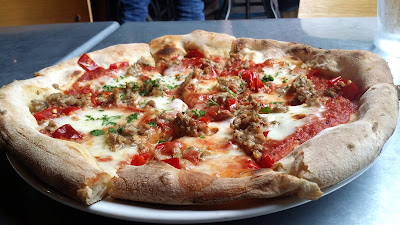Stella is located in the Southtown section, a trendy spot with bars, restaurants, stately old homes, and bikes to rent. It's very much a different world than the north end of the River Walk or the Alamo tourist area. Stella is among the the artisanal restaurants working in the "farm-to-table" mode, opting for local sourcing where possible.
From the website:
Stella’s “farm to pizza” concept is centered on strong partnerships with local growers, ranchers, and purveyors. The star is Texas-sourced wood-fired pizza baked in an Italian Modena oven, using oak and pecan wood. Shared plates, house-made cheeses, and fresh salads are made with locally-sourced ingredients. There are 20 rotating craft beers on tap and an internationally-curated wine list.
I arrived around 11:45am on a Sunday, and the airy open space was about half full. By 12:30, Stella was packed and buzzing loudly. There is a mix of seating options - conventional tables, bar seating, and long common tables. The space seems to be a converted factory or warehouse, and the interior has a pleasant hipster vibe.
The menu includes small plate appetizers, salads, and pizza. I would have liked to sample some of the non-pizza items, but I was dining solo and opted for just one pie. There are several interesting options for these large personal size (14") pizzas, and I chose the Spicy Italian Sausage pie ($15).
As with any pizza worth the calories, the crust is the key element. This one seemed to be a Neapolitan hybrid. It sported the leopard spots and puffy cornicione common to Neapolitan pies, but it was improved by being a bit sturdier and crisper. Unlike some traditional Neapolitans, it didn't have a wet center or soggy spots.
A bit more about that crust - beyond its terrific texture, it had a pronounced flavor of its own, and tasted almost like sourdough. The cornicione was more dense and chewy than most, too. All of these features elevated the crust and the entire pie.
The first flavor I noted in the pie was the sausage. The fennel-packed chunks were large, uneven, and had clearly cooked on and into the pie. Sausage that cooks on the pizza is so much better than the pre-cooked variety. I made a mental note that this sausage had an incredibly good flavor.
There was a generous amount of thinly sliced Calabrian red peppers on this pie. I suspect they may have been pre-cooked a bit; they had the ideal soft texture. They added a kick of heat but not so much as to burn out the other flavors.
The mozzarella appeared conventional, but it had a bolder taste than most and also an ideal stretchiness. Just as importantly, it was applied in proper proportion so that it didn't contribute too much moisture or weight to overwhelm the crust.
The sauce was a deep red, and it was rich and thick. Its flavor stood up to the spicy pepper and savory sausage. It was a bit salty, which is a good thing to me, because I typically add salt to pizza. This pie needed none because its flavors were in harmony.
In fact, the overall theme here was that it was an optimally balanced pizza. The flavors and textures and proportions were ideal. The elements for this pizza were especially well-mated. So many times, topping combos that sound good don't work out so well. With this essentially perfect pie, any extra topping probably would have reduced its appeal (even as I was tempted by the option to add an egg to it).
 |
| Lamb meatballs |
 |
| The Bee Sting |
 |
| Spicy sausage pie |
Is this destination pizza? Absolutely. It was a delightful reward for the 30 minute walk from the tourist center of San Antonio. It's the best pie I've had here and it would contend with the best in any city.













No comments:
Post a Comment